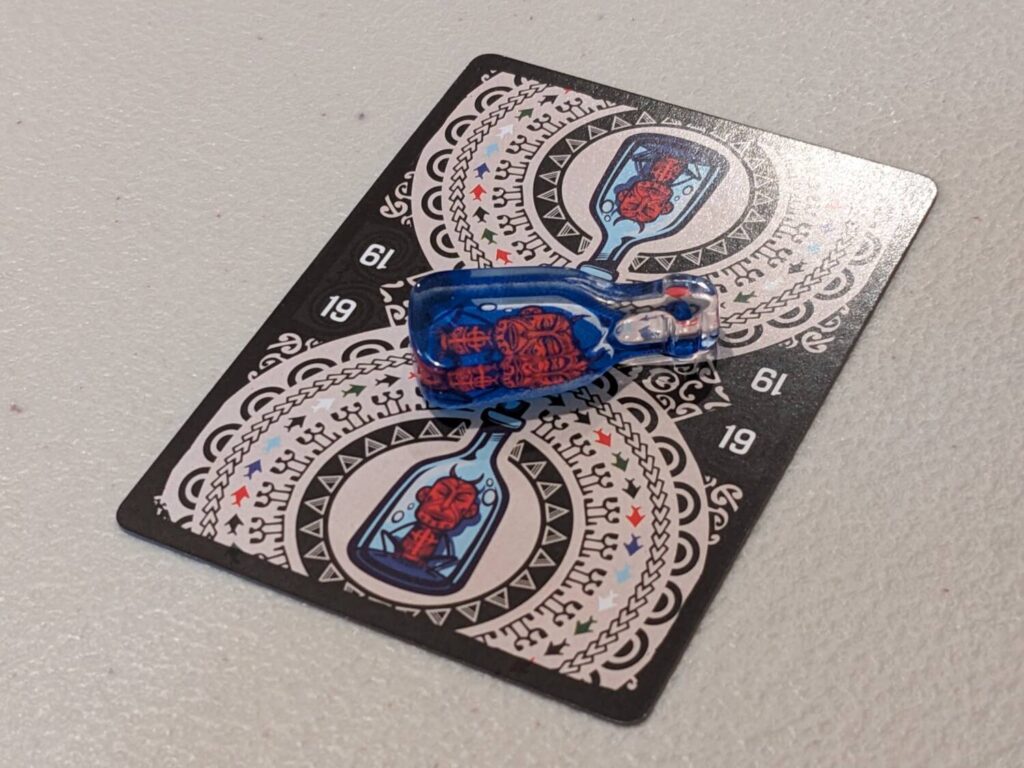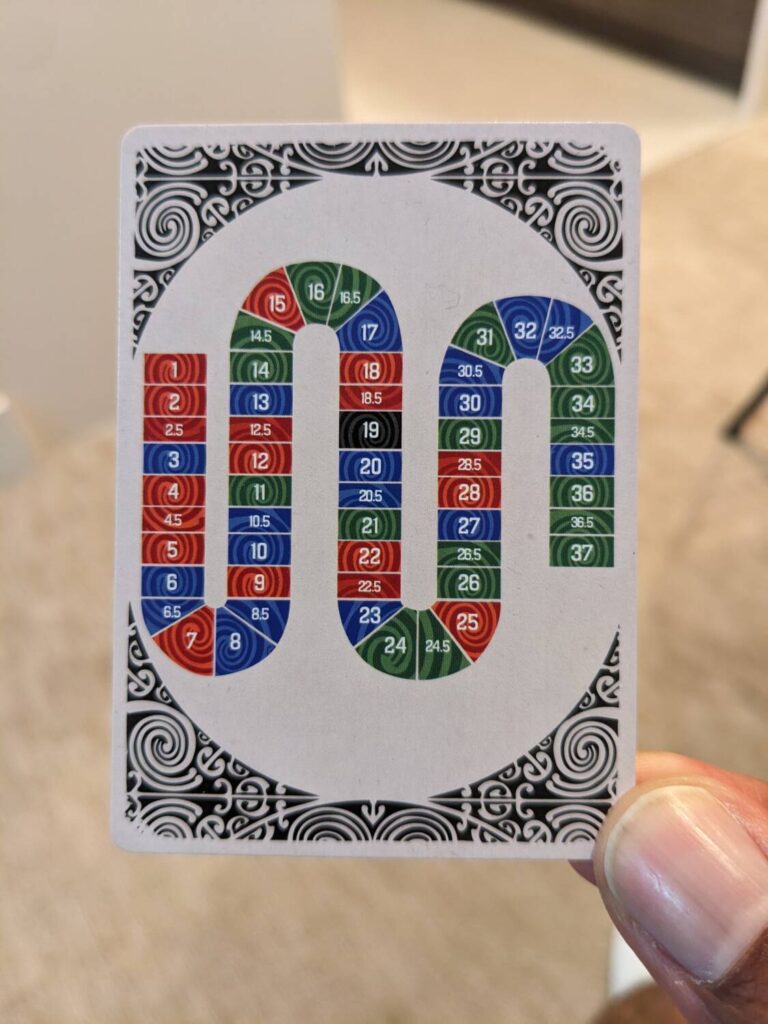Disclosure: Meeple Mountain received a free copy of this product in exchange for an honest, unbiased review. This review is not intended to be an endorsement.
I’m leaning as hard as ever into quick-playing card games, in part because the industry can’t churn a trick-taker out fast enough these days.
Our partners at Matagot provided a review copy of Bottle Imp, a remake of The Bottle Imp, a game that was released all the way back in 1995, before the dawn of tabletop time. (I’m only partially kidding here.) In both the old and new versions, the game’s conceit is simple—you want to win tricks, at least until you definitely do not want to win tricks…and if you end the game with the devilish bottle in question, all the points you score in that round are negative, while everyone else scores positive points.
There’s a bit more to it than that, but not really. Bottle Imp freshens the shine a bit with a very refined set of rules and an exceptionally well-drawn and textured card back that feels great in the hands and is easy on the eyes. I’m glad I had the chance to get my first play in with the Matagot team because I think that smoothed over a rulesheet that confused me the first time I read it on my own. After playing the base game version with friends, we had the game down by the end of the first round.
So, how is Bottle Imp? I think it depends on the format. One thing was clear—no matter what the format was, we found ourselves enjoying a few highs each game while openly wondering about the legs of that bottle.

Deal with the Devil in the Bottle
Bottle Imp is a 2-6 player trick-taking game with “must follow” rules that can be played as a duel, as a standard game with 3-4 players, or as a team game with four or six players. No matter what the format is, the goal is to score the most points by taking tricks and scoring positive points at the end of each round. One player or team will lose points in each round if they have possession of the Bottle Imp, a small plastic bottle token that rests on top of a pile of cards that equates to negative points for the bottle’s owner.
In the standard version of the game (for three or four players, playing individually), a deck of 36 cards is dealt equally amongst the players. Those cards run from 1-37 and are valued at 2-5 points per card, with one exception—there’s no 19 in the deck. That 19 card, the middle of that 1-37 numerical sequence, is worth zero points and begins play in the middle of the table with the bottle token on top and one card from each player that was secretly planted under the 19 card before the round begins. This pile, along with any tricks taken by the eventual owner of the bottle, will score negative points for whoever ends the round in possession of the bottle.
After players pass two hand cards—one to each immediate neighbor—play begins. A player must lead the trick by playing a card, then others who have any cards of the led suit (red, blue or green) must play a card. If the active player is out of a suit, they can play any card they would like. Here’s the trick—if all players play a card above 19, whoever plays the highest numbered card (regardless of suit!) wins the trick.
If even one player plays below the 19, the player who played the card closest to 19 wins the trick. So, if Teddy plays a 30, I play an 18, and you play a 21, I win the trick because my card (the 18) was lower than 19.. Then the 19 card is thrown out of the game, the 18 becomes the new watermark for playing above or below a certain number, and I become the owner of the Bottle Imp.
So everyone is trying to figure out when they can get rid of their lowest cards in order to not be in a position where the Bottle Imp card is so low that no one can play below it. (Even the rules indicate that a terrible idea would involve winning the Bottle Imp with a 1 or a 2, because if the lowest card in the game wins the Imp, you are destined to end the round by scoring negative points since no one else can take the Imp from you!)
That means it is pretty interesting to see if you can navigate the waters well enough to end play without that Imp…but it was also certain even by my fourth round of Bottle Imp that strategy wouldn’t change much from game to game. If I am dealt a solid hand of medium to high numbers, I won’t have much of a chance of losing since the Bottle Imp always seems to end up with a player who has a lot of low numbers.

Interesting, At Least for a Little While
It was always a blast to see how a round would play out to see who would get hosed by the Bottle Imp. Cursing always ensued, and clever players were usually able to hold on to a lead if they could avoid taking the Imp.
But I was surprised how often each round played out mostly the same. Everyone would bury and/or pass their three lowest cards (under the 19 card to begin a round, then passing the other two to neighbors), or in some cases they would pass the one card they had of a suit so that they wouldn’t get hosed if someone played a suit where they only had a single low card in a suit. The player who got a lot of the high cards in the 30s typically took most of the tricks, and playing a card that was just below the current watermark led to players who took turns later trying to dump their lowest remaining cards if possible.
Plenty of great games require the use of a single strategy to win, but it was more pronounced here in Bottle Imp than I was expecting.
Bottle Imp is a tidy production that’s easy to teach and fun to play for a few rounds. It doesn’t really have a catch-up mechanic, so it really never mattered how many points anyone scored from round to round—if you can avoid the Imp and other players have even a single negative point round, the player who stayed above water always won. And the scores are sometimes lopsided—we had a game where a winner after just three rounds won by more than 170 points, which didn’t seem to feel good for the guy who finished with the Imp in two of our three rounds.
Players can agree on any game length they want, so it’s easy to get around a player that is lapping the field by just conceding the game.
Bottle Imp wasn’t bad, but it’s not a game I expect to whip out very often. Give this a look for the team variant, which spices up play beyond the base game’s rules.











